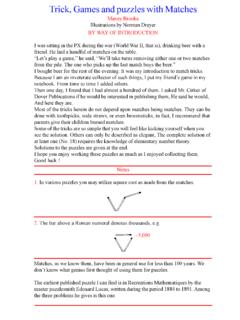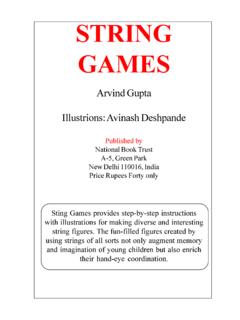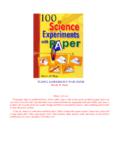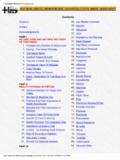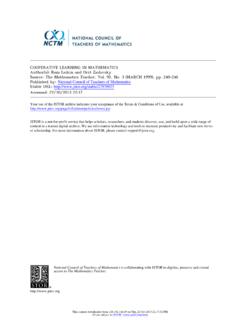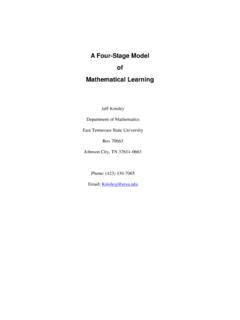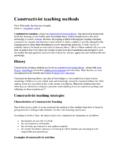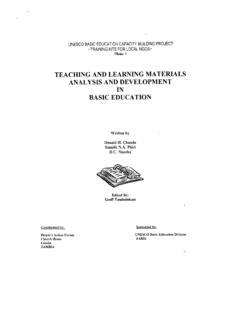Transcription of THE MATHS TEACHER’S HANDBOOK - …
1 THE MATHS TEACHER'S HANDBOOK . JANE PORTMAN. JEREMY RICHARDON. INTRODUCTION. Who is this book for? This book is for mathematics teachers working in higher primary and secondary schools in developing countries. The book will help teachers improve the quality of mathematical education because it deals specifically with some of the challenges which many MATHS teachers in the developing world face, such as a lack of ready-made teaching aids, possible textbook shortages, and teaching and learning MATHS in a second language. Why has this book been written? Teachers all over the world have developed different ways to teach MATHS successfully in order to raise standards of achievement. MATHS teachers have developed ways of using locally available resources adapted mathematics to their own cultural contexts and to the tasks and problems in their own communities introduced local MATHS -related activities into their classrooms improved students' understanding of English in the MATHS classroom.
2 This book brings together many of these tried and tested ideas from teachers worldwide, including the extensive experience of VSO MATHS teachers and their national colleagues working together in schools throughout Africa, Asia, the Caribbean and the Pacific. We hope teachers everywhere will use the ideas in this book to help students increase their mathematical knowledge and skills. What are the aims of this book? This book will help MATHS teachers: find new and successful ways of teaching MATHS make MATHS more interesting and more relevant to their students understand some of the language and cultural issues their students experience. Most of all, we hope this book will contribute to improving the quality of mathematics education and to raising standards of achievement.
3 WHAT ARE THE MAIN THEMES OF THIS BOOK? There are four main issues in the teaching and learning of mathematics : teaching methods Students learn best when the teacher uses a wide range of teaching methods. This book gives examples and ideas for using many different methods in the classroom, Resources and teaching aids Students learn best by doing things: constructing, touching, moving, investigating. There are many ways of using cheap and available resources in the classroom so that students can learn by doing. This book shows how to teach a lot using very few resources such as bottle tops, string, matchboxes. The language of the learner Language is as important as mathematics in the mathematics classroom. In addition, learning in a second language causes special difficulties.
4 This book suggests activities to help students use language to improve their understanding of MATHS . The culture of the learner Students do all sorts of MATHS at home and in their communities. This is often very different from the MATHS they do in school. This book provides activities which link these two types of rnaths together. Examples are taken from all over the world. Helping students make this link will improve their mathematics . HOW DID WE SELECT THE ACTIVITIES AND teaching . IDEAS IN THIS BOOK? There are over 100 different activities in this book which teachers can use to help vary their teaching methods and to promote students'. understanding of MATHS . The activities have been carefully chosen to show a range of different teaching methods, which need few teaching aids.
5 The activities cover a wide range of mathematical topics. Each activity: shows the mathematics to be learned contains clear instructions for students introduces interesting ways for students to learn actively. What is mathematics ? mathematics is a way of organising our experience of the world. It enriches our understanding and enables us to communicate and make sense of our experiences. It also gives us enjoyment. By doing mathematics we can solve a range of practical tasks and real-life problems. We use it in many areas of our lives. In mathematics we use ordinary language and the special language of mathematics . We need to teach students to use both these languages. We can work on problems within mathematics and we can work on problems that use mathematics as a tool, like problems in science and geography.
6 mathematics can describe and explain but it can also predict what might happen. That is why mathematics is important. learning and teaching mathematics learning skills and remembering facts in mathematics are important but they are only the means to an end. Facts and skills are not important in themselves. They are important when we need them to solve a problem. Students will remember facts and skills easily when they use them to solve real problems. As well as using mathematics to solve real-life problems, students should also be taught about the different parts of mathematics , and how they fit together. mathematics can be taught using a step-by-step approach to a topic but it is important to show that many topics are linked, as shown in the diagram on the next page.
7 It is also important to show students that mathematics is done all over the world. 1234. 1234. 1234. 1234. 1234. 1234. 1234. 1234. 1234. 1234. 1234. 1234. 1234. 1234. 1234. 1234. Although each country may have a different syllabus, there are many topics that are taught all over the world. Some of these are: number systems and place value arithmetic algebra geometry statistics trigonometry probability graphs measurement We can show students how different countries have developed different MATHS to deal with these topics. How to use this book This book is not simply a collection of teaching ideas and activities. It describes an approach to teaching and learning mathematics . This book can be best used as part of an approach to teaching using a plan or scheme of work to guide your teaching .
8 This book is only one resource out of several that can be used to help you with ideas for activities and teaching methods to meet the needs of all pupils and to raise standards of achievement. There are three ways of using this book: Planning a topic Use your syllabus to decide which topic you are going to teach next, Find that topic in the index at the back of the book. Turn to the relevant pages and select activities that are suitable. We suggest that you try the activities yourself before you use them in the classroom. You might like to discuss them with a colleague or try out the activity on a small group of students. Then think about how you can or need to adapt and improve the activity for students of different abilities and ages.
9 Improving your own teaching One way to improve your own teaching is to try new methods and activities in the classroom and then think about how well the activity improved students' learning . Through trying out new activities and working in different ways, and then reflecting on the lesson and analysing how well students have learned, you can develop the best methods for your students. You can decide to concentrate on one aspect of teaching MATHS : language, culture, teaching methods, resources or planning. Find the relevant chapter and use it. Working with colleagues Each chapter can be used as material for a workshop with colleagues. There is material for workshops on: developing different teaching methods developing resources and teaching aids culture in the MATHS classroom language in the MATHS classroom planning schemes of work.
10 In the workshops, teachers can try out activities and discuss the issues raised in the chapter. You can build up a collection of successful activities and add to it as you make up your own, individually or with other teachers. CHAPTER 1. teaching METHODS. This chapter is about the different ways you can teach a topic in the classroom. Young people learn things in many different ways. They don't always learn best by sitting and listening to the teacher. Students can learn by: practising skills on their own discussing mathematics with each other playing mathematical games doing puzzles doing practical work solving problems finding things out for themselves. In the classroom, students need opportunities to use different ways of learning .




